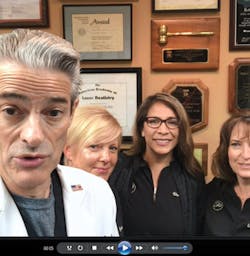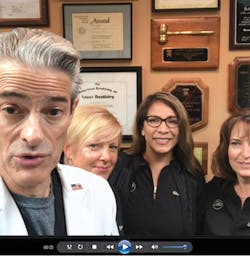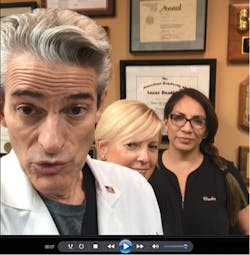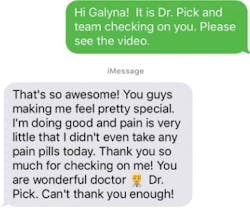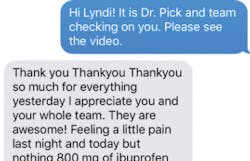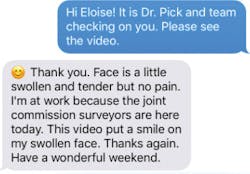The Pick postprocedural video check (the ‘Triple P, VC’)
Robert M. Pick, DDS, MS
About six months ago, I was awakened in the middle of the night by a brainstorm. I was fortunate to record it before drifting off again. After I listened to it in the morning, analytically considered it on the way to work, and discussed it during the morning huddle with my team, we applied it and have used it ever since with success. It has become a daily staple and one of the most essential internal marketing activities that we do to bring new patients through the door.
We call it the Pick postprocedural video check, or the Triple P, VC. The Triple P, VC involves video and text messaging, so flawless execution requires a little homework. Moreover, you must check and comply with all HIPAA regulations. Since you will be sending the patient a video message via text, it is crucial that you obtain patient consent beforehand. If you have any questions, consult your attorney or a HIPAA expert prior to proceeding.
Once we’ve obtained a patient’s consent to communicate via text, we begin the Triple P, VC process. It begins with what we affectionately refer to as Ye Ole Call Sheet. This is a document containing patients’ names and contact information. We use the call sheet to gather essential patient contact information on the day of the procedure, and then later, we use that call sheet to follow up to see how the patient is doing that evening. This information includes the patient’s name and home, work, and mobile numbers, as well as details about the procedure performed. Why go through this trouble? It’s simple—practice marketing. The same-day call from you, the doctor, will blow the patient out of the water. Most doctors know about calling the patient the night of a procedure, but very few do it. But what comes next—the Triple P, VC—will generate amazing reviews and referrals in today’s tech-savvy society.
The day after you’ve made your postprocedural call using Ye Old Call Sheet, you record and send the Triple P, VC. The assisting team and I assemble in our conference room to record the video checkup immediately after our morning huddle (figure 1). Using the call sheet, we go down the list of patients from the previous day and determine to whom we will send videos. We send videos to patients who have had procedures such as the following:
- Crown preparations
- Crown placement
- Veneer placement
- Surgical extractions
- Implant placement
- Denture insertions
- Periodontal surgery
- Scaling and root planing
- Endodontic procedures
- Occlusal adjustments
- Local anesthetic
- Emergency visits
By using the information gathered from the previous night’s patient calls, you are factually up-to-date for the video.
It is never been easier to film quality video. All you need is a smartphone. But here are a few quick tips:
- Use a professional background. We use one of the walls in our conference room that has some of our awards.
- Never film shooting into a light source. You may want to close all of the blinds in that particular room.
- If you are shooting with a smartphone, use a smartphone stabilizer. We like one made by SMove, but any quality model will do. The stabilizer takes the shake out of the video, and many models will allow you to pan, tilt, and zoom with the touch of a button.
Most videos average 32–45 seconds in length and no longer. Here’s a typical script: “Hi, Joan. It’s Dr. Smith and my assisting team, Mary and Jane, checking on you. We want to make sure that there are no residual effects from the anesthetic, that your veneers still feel and look great, and that there are no bite issues. If there are any problems day or night, please feel free to contact me at (555) 321-1234 at any time, 24/7. This is also our office cell, (555) 321-4321. Please feel free to text us back and let us know how you are doing.”
Why go through the trouble? Smartphone video has brought us into a golden age of communication. With minimal effort, you can give patients something personal and special. This fosters the doctor-patient relationship, builds trust, and creates an experience that is unique to your practice. We live in an age of video, and people like to watch video, period. It has been shown that the human brain processes visuals 60,000 times faster than it decodes text.1
Review the video (or have an assistant review it) prior to sending. Be certain that you are sending it to the correct number! We send all videos with the following standard text: “Hi, Joan! It is Dr. Smith and team checking on you. Please see the video.” We do one final check of the video and the number before pressing send, and then the video is on its way.
The text is copied and pasted from a set place on the smartphone. This saves time and helps us get the message correct with a simple name change. In the Reminders app, we have a title of Triple P, VC, and the first line is the standard text.
Timing delivery is everything. We aim for slightly before lunch. That’s because the delighted and absolutely amazed patient is more likely to show his or her coworkers your video over lunch, doing some automatic marketing work for you.
Your patients will be blown away. We have been told by most recipients that they also showed family and friends later in the day or the days following. Expect patients to text back with compliments and gratitude (figures 2–5).
Figures 2–5: Replies from patients
Today’s information-loving consumers have demands. They want their information on mobile, they want it instantly, and they want the immediacy and intimacy of video. Video will make up more than 82% of internet traffic by 2021.2 Audiences are 40 times more likely to engage and share video posts on social media.3 Finally, 51.9% of marketing professionals say video has the best ROI.4
If you want to create a meaningful patient experience—one that will make patients market your practice for you—you must use video.
In summary, this has been the most amazing internal marketing strategy for our practice and for the teams that we coach—with the best return on investment. My team and I believe that once you start performing the Triple P, VC, you will never not do it!
References
1. Kusinitz S. 12 reasons to integrate visual content into your marketing campaigns.” HubSpot website. https://blog.hubspot.com/marketing/visual-content-marketing-infographic. Published July 18, 2014. Accessed October 8, 2017.
2. VNI global fixed and mobile internet traffic forecasts. Cisco website. https://www.cisco.com/c/en/us/solutions/service-provider/visual-networking-index-vni/index.html#~complete-forecast. Accessed September 20, 2018.
3. Lee K. 9 informative infographics to guide your visual content marketing. Buffer website. https://blog.bufferapp.com/infographics-visual-content-marketing. Accessed September 20, 2018.
4. Lloyd D. SEO for success in video marketing. Adobe website. https://theblog.adobe.com/seo-for-success-in-video-marketing. Accessed September 20, 2018.
